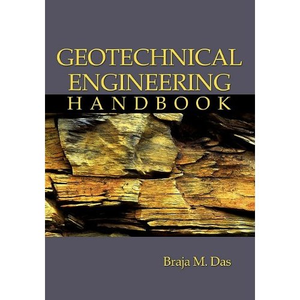Engineering properties of soil
Sivakugan, Nagaratnam (2011) Engineering properties of soil. In: Das, Braja M., (ed.) Geotechnical Engineering Handbook. J Ross Publishing, Fort Lauderdale, FL, USA, p. 1.
![[img]](https://researchonline.jcu.edu.au/14913/2.hassmallThumbnailVersion/14913_Sivakugan_2010_Book_Cover.jpg)
|
Image (JPEG) (Book Cover)
- Cover Image
Download (52kB) |
|
|
PDF (Published Version)
- Published Version
Restricted to Repository staff only |
Abstract
[Extract] The earth is about 12,500 km in diameter. All geotechnical activities including underground excavations, tunneling, etc. are limited to the upper part of the crust, which consists primarily of oxygen (49.2%), silicon (25.7%), aluminum (7.5%), and other elements such as iron, calcium, sodium, potassium, and magnesium. These are present mostly in the form of aluminium silicates. All clay minerals are made primarily of two distinct structural units, namely tetrahedrons and octahedrons, which contain silicon and aluminum ions, respectively, at the center of the units. Several of these units can form tetrahedral or octahedral sheets that can be stacked on each other, forming different clay minerals. Clay particles are colloidal, where surface forces have greater influence than the body forces, less than 2 μm in size, and have net negative charges. They look like flakes or needles under a microscope. Depending on their charge imbalance, mineralogy, and pore fluid characteristics, they can form a flocculated (random) or dispersed (oriented) matrix, which can influence their fundamental behavior. Kaolinite, montmorillonite, and illite are three of the most common clay minerals. Other clay minerals include chlorite, attapulgite, halloysite, and vermiculite. Montmorillonites have the largest cation exchange capacity and specific surface (surface area per unit mass) and can swell significantly in the presence of water, thus posing a serious threat to the structural integrity of buildings and roads due to intermittent swelling and shrinking. Montmorillonitic clays are known as expansive or reactive clays and cause millions of dollars worth of damage every year worldwide.
Soils are primarily of two types: residual or transported. Residual soils are formed by disintegration of the parent rock. Depending on the geologic process by which the parent rock is formed, it is called igneous, sedimentary, or metamorphic. Igneous rocks (e.g., granite) are formed by cooling of lava. Sedimentary rocks (e.g., limestone, shale) are formed by gradual deposition of fine particles over long periods. Metamorphic rocks (e.g., marble) are formed by altering igneous or sedimentary rocks by pressure or temperature.
Transported soils are soils that are transported by glacier, wind, water, or gravity and deposited away from their geological origin. Depending on whether they are transported by wind, sea, lake, river, ice, or gravity, the soils are called aeolian, marine, lacustrine, alluvial, glacial, or colluvial, respectively. Some special terms used to describe certain soils are:
• Boulder clay—Unstratified mixture of clay and rock fragments of all sizes
• Calcareous soil—Soil that contains calcium carbonate
• Conglomerate—Cemented sand and gravel
• Dispersive clay—A clay that is easily erodible under low-velocity water
• Fat clay—Highly plastic clay
• Hardpan—Very dense soil layer, often cemented, that is difficult to excavate
• Loam—Mixture of sand, silt, and clay used as topsoil
• Loess—Uniform silt-sized wind-blown deposits
• Laterite—Red-colored residual soil in the tropics
• Reactive clay—Expansive clay that swells when in contact with water
• Varved clay—Thin alternating layers of silts and fat clays of glacial origin
| Item ID: | 14913 |
|---|---|
| Item Type: | Book Chapter (Research - B1) |
| ISBN: | 978-1-932159-83-7 |
| Date Deposited: | 11 Nov 2010 04:07 |
| FoR Codes: | 09 ENGINEERING > 0905 Civil Engineering > 090501 Civil Geotechnical Engineering @ 100% |
| SEO Codes: | 87 CONSTRUCTION > 8702 Construction Design > 870201 Civil Construction Design @ 100% |
| Downloads: |
Total: 565 Last 12 Months: 9 |
| More Statistics |



